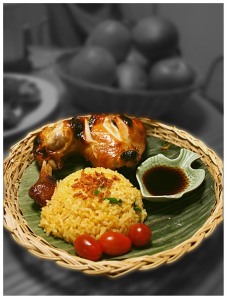 When I first arrived in country, I stayed at a hostel in Manila called Friendly’s Guesthouse. There I met a British ex-pat living in Malaysia that has been on the road for the past twenty years. He was at the end of a three-month trip through the Philippines, and he really hated the food here. When we talked about the typhoon, Ondoy, that hit Manila last fall, he said the streets were so flooded that the government had difficulty getting food to the inhabitants up north. “You’d think they’d be celebrating,” he said.
When I first arrived in country, I stayed at a hostel in Manila called Friendly’s Guesthouse. There I met a British ex-pat living in Malaysia that has been on the road for the past twenty years. He was at the end of a three-month trip through the Philippines, and he really hated the food here. When we talked about the typhoon, Ondoy, that hit Manila last fall, he said the streets were so flooded that the government had difficulty getting food to the inhabitants up north. “You’d think they’d be celebrating,” he said.
This is usually the first and, more often than not, the second and third impression of foreigners in the Philippines. For one thing, the food in the Philippines is much less spicy and flavorful than its Southeast Asian counterparts. Thailand, Vietnam, Indonesia, even Cambodia use a wider array of spices, giving to food a kick unlike anything you’d really find here in the Philippines. But the reality is that food in the Philippines is delicious, if you know what to order.
Adobo
Adobo is the most famous style of Filipino cooking, with hundreds of different varieties. There is an adobo festival every year in the neighboring town of Silay that I will regrettably miss. The sauce ends up being a thick brown color and has a sweet and somewhat spicy taste, depending on the type of adobo. The basic ingredients of adobo are actually simple:
Typically, pork or chicken, or a combination of both, is slowly cooked in soy sauce, vinegar, crushed garlic, bay leaf, and black peppercorns, and often browned in the oven or pan-fried afterward to get the desirable crisped edges. This dish originates from the northern region of the Philippines.
Any type of meat can be cooked adobo-style, with chicken and pork as the two most common. As with every food in the Philippines, adobo-style meats are paired with white or garlic rice. Knives are generally not used. Instead, it is customary to use a fork and large spoon. You cut the meat with the side of the spoon, and push the meat, vegetables onto the spoon together with rice and eat them together.
Inasal
Inasal, or barbecue, is actually indigenous to the island of Negros – the place I call home. Chicken is the most common type of inasal, though pork is popular as well. Originally a street food here in Bacolod, chicken inasal is a breast or thigh on a skewer. It is covered in a type of barbecue sauce, though not the same type as on a barbecued chicken sandwich in the States. It is served on a banana leaf with a cup of rice, and everything is to be eaten with your hands. The dipping sauce is a combination of vinegar, chilis, soy sauce, and calamansi (small limes). The best place to get chicken inasal in Bacolod is an open-air strip shanty mall with ten identical restaurants, all serving the exact same menu. Manokan (chicken) Country, as it is called, owes its existence to the government rounding up the street vendors selling inasal and giving them their own place to cook. Hear what a native Filipino has to say about this street food:
Thanks to the entrepreneurial savvy of the Ilonggos (native Negrenses), the lowly Chicken Inasal(grilled chicken on a bamboo skewer) has crossed borders from the sugar frontier to the Philippine metropolis. Like the legendary La paz Batchoy, it has inched it’s way to carve a niche in the national palate. You can see Manokan s(grilled chicken eateries) sprouting even in the air conditioned chi-chi malls; most of whom claim to be the orig.
In a previous post titled “Mr. Inasal and Me,” I talked about my experience at a restaurant called Mang Inasal. Mang Inasal, which specializes in chicken inasal, is one of the most popular fast-food restaurants in the country. Whenever you ask someone about Mang Inasal, they are always quick to point out that the owner is actually from Iloilo, not Bacolod. He took the idea and ran with it. I am certainly not complaining, but I will always prefer Manokan Country, the In n’ Out Burger of chicken inasal.
In the next food post, I will discuss more types of cooking and the different meats and vegetables popular here in the Philippines. I will close it out with a list of my favorite dishes.


Don’t forget to add lechon. Lechon is another type of cooking. It’s roasting, usually a pig, under the heat of the sun and charcoal underneath. The insides are usually stuffed with lemongrass and other spices.
Oh by the way, you got a nice photo there with the pork barbecue there. Makes my mouth water. Yum yum!